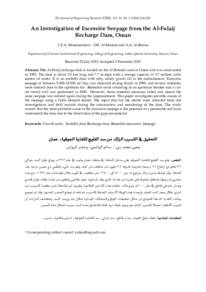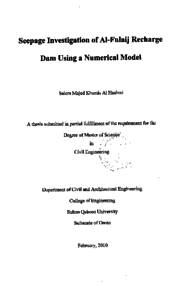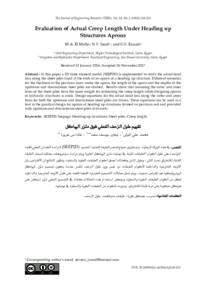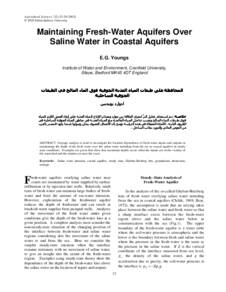Document
An investigation of excessive seepage from the Al-Fulaij Recharge Dam, Oman.
Contributors
Al-Hashmi, S. M., Author
Al-Rawas, A. A., Author
Publisher
Sultan Qaboos University.
Gregorian
2016
Language
English
English abstract
The Al-Fulaij recharge dam is located on the Al Batinah coast in Oman and was constructed in 1992. The dam is about 3.3 km long and 7.7 m high with a storage capacity of 3.7 million cubic meters of water. It is an earthfill dam with silty, sandy gravel fill in the embankment. Excessive seepage of between 5,000–12,500 m3/day was observed during floods in 1993, and several sinkholes were noticed close to the upstream toe. Remedial work consisting of an upstream blanket and a cutoff trench wall was performed in 2000. However, these remedial measures failed and almost the same seepage was noticed again during the impoundment. This paper investigates possible causes of the seepage using a finite element model. The input data for the model were collected from site investigations and field records during the construction and monitoring of the dam. The study reveals that the most probable cause of the excessive seepage is the presence of a permeable soil layer underneath the dam due to the dissolution of the gypsum material.
Member of
ISSN
1726-6742
Resource URL
Citation
Mohamedzein, Y. E. A., Al-Hashmi, S. M., & Al-Rawas, A. A. (2016). An investigation of excessive seepage from the Al-Fulaij Recharge Dam, Oman. The Journal of Engineering Research, 13 (2), 124-136.
Arabic abstract
يقع سد الفليج للتغذية الجوفية على ساحل الباطنة في سلطنة عمان وشيد في عام 1992 م. ويبلغ طول السد حوالي 3.3 كم مع ارتفاع 7.7 م بسعة تخزينية قدرها 3.7 مليون متر مكعب من المياه. وهو سد مليء بالطمي مع حصى ترابية عند الحافة. وقد لوحظ تسرب زائد يتراوح ما بين 5000 إلى 12500 متر مكعب في اليوم خلال فيضانات عام 1993، مع عدة مجاري تم رؤيتها بشكل ملحوظ على مقربة من مقدمة المنبع. وقد تم تنفيذ عمل علاجي يتكون من إنشاء غطاء عازل للمنبع وجدار خندقي قاطع في عام 2000 م. ومع ذلك، فشلت هذه التدابير العلاجية وتقريبا تم ملاحظة نفس كمية التسرب مرة أخرى خلال حجز السد للمياه. وتبحث هذه الورقة الأسباب المحتملة للتسرب باستخدام نموذج العنصر المحدود. وقد تم تجميع بيانات التغذية المدخلة للنموذج من خلال تحقيقات الموقع والسجلات الميدانية خلال بناء ورصد السد. وتكشف الدراسة أن السبب الأكثر احتمالا للتسرب الزائد هو وجود طبقة تربة قابلة للاختراق تحت السد بسبب انحلال مادة الجبس.
Category
Journal articles




